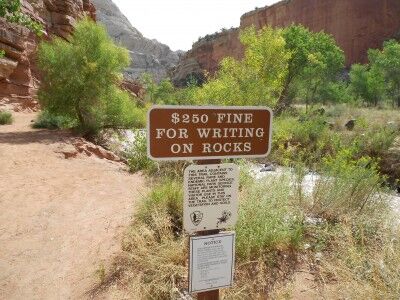One of the things that distresses me when visiting the National Parks is that is seems that more and more people find it necessary to leave their name inside the National Parks. I’m not sure why people feel the need to deface these natural wonders — what is it that makes people think that it’s a good idea to spray paint or carve their name into the rocks at National Parks? It saddens me to no end that signs like this actually need to be posted these days in National Parks (this one was found at Capitol Reef National Park):

I remember hiking in Arches National Park well away from the most visited places and running into a ranger that was cleaning up marks that people had left on some of the remote arches. He said it was a constant battle because if people see that one person has done it, they feel it’s OK for them to do it as well. Sharpie markers, along with gum, were the bane of his existence.
If you ever see park rangers out and about cleaning the natural wonders that we visit, be sure to thank them — and don’t be shy in discouraging anyone from marking natural wonders in the National Parks…

This is becoming an increasing problem that we’ve noticed too over the years, mainly at petroglyph sites. Why do people feel they need to leave their mark and ruin works done by people possibly thousands of years ago?
Ironically, in the very place you mention, Capital Reef National Park, there is the “Pioneer Register” which are etchings made by a group of pioneers in 1911. That isn’t too long ago. They are also located nearby typical Native American petroglyphs.
A similar scenario exists in the Mojave National Preserve in California. At Camp Rock Springs, a rock etching was made just after the Civil War by passing infantrymen using the Mojave Road. These exist just across from Native American petroglyphs etched in darker rock.
Is it just human nature to make their mark where other people have left their mark before? Wouldn’t graffiti created today be viewed as “petroglyphs” hundreds of years from now?
The bottom line however, is that these writings from just a hundred years ago to perhaps thousands of years ago need to be preserved and not be covered up with other “etchings”. One thing that has changed over the past 50 years is the sheer number of people now able to visit these remote areas where such petroglyphs exist. So no matter what type of human nature exists, the public needs to take a responsibility to preserve the artifacts left by our ancestors.
Cliff Bandringa